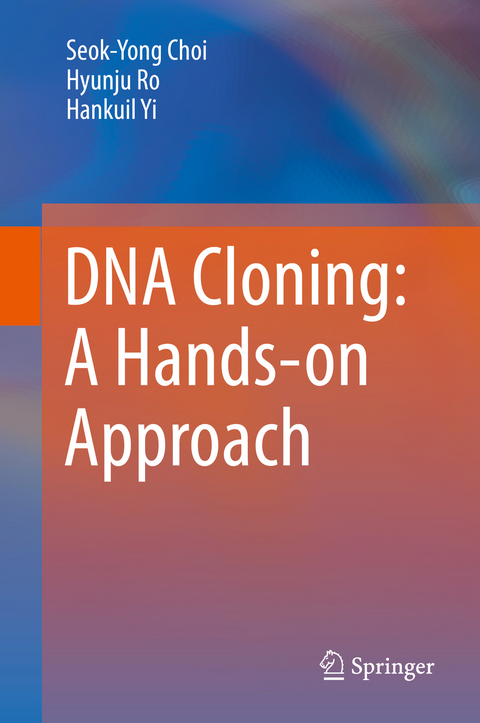
DNA Cloning: A Hands-on Approach
Springer (Verlag)
978-94-024-1660-2 (ISBN)
Seok-Yong Choi, Department of Biomedical Sciences, Chonnam National University College of Medicine, Gwangju, Republic of Korea Hyunju Ro, Department of Biological Sciences, Chungnam National University, Daejeon, Republic of Korea Hankuil Yi, Department of Biological Sciences, Chungnam National University, Daejeon, Republic of Korea
Part I. What is cloning?.- Chapter 1.1 Definition of cloning.- Chapter 1.2 Discovering a new gene.- Chapter 1.3 Cloning in the past.- Chapter 1.4 Cloning in the present.- Part II. A prerequisite for cloning.- Chapter 2.1 Software useful for cloning design.- Chapter 2.2 Vector, plasmid, construct and the Kozak consensus sequence.- Chapter 2.3 Multiple cloning sites (MCS).- Chapter 2.4 Restriction endonucleases and star activity.- Chapter 2.5 Agarose gel electrophoresis.- Chapter 2.6 Pouring LB agar plates.- Chapter 2.7 Competent cells.- Chapter 2.8 The conversion of DNA mass into molar concentration.- Chapter 2.9 Upon receiving new plasmids.- Chapter 2.10 cDNA library.- Part III. The first step in cloning.- Chapter 3.1 Cut & paste.- Chapter 3.2 DNA sequencing and direct sequencing.- Chapter 3.3 PCR and nested PCR.- Chapter 3.4 Fill-in (Full & Partial).- Chapter 3.5 Compatible cohesive ends.- Chapter 3.6 Methylation.- Chapter 3.7 Three-piece ligation.- Chapter 3.8 Site-directedmutagenesis.- Chapter 3.9 Structure of plant transformation vectors.- Chapter 3.10 Transformation of R. radiobacter.- Part IV. The next step of cloning.- Chapter 4.1 How to insert a DNA fragment into a gene.- Chapter 4.2 How to delete an internal region of a gene.- Chapter 4.3 How to insert an epitope tag into a gene.- Chapter 4.4 Translational fusion vs. transcriptional fusion.- Part V. The last steps of cloning.- Chapter 5.1 Method for cloning similar genes in different species.- Chapter 5.2 RACE (rapid amplification of cDNA ends).- Chapter 5.3 BAC recombineering.- Chapter 5.4 Old trick: partial digestion.- Chapter 5.5 Modification of a vector.- Chapter 5.6 When you notice a frame shift mutation upon cloning.- Chapter 5.7 Reality of cloning: an extremely unlucky case.- Part VI. Methods that make your cloning life easier.- Chapter 6.1 TA cloning and production of a T-vector.- Chapter 6.2 TOPO TA cloning.- Chapter 6.3 Gateway cloning.- Chapter 6.4 Golden Gate Assembly for a modular cloning.- Chapter 6.5 In-Fusion Sequence and Ligation-Independent Cloning (In-Fusion SLIC).- Chapter 6.6 T4 DNA Polymerase Sequence-and Ligation-Independent Cloning (T4 DNA Pol SLIC).- Chapter 6.7 Non-template PCR cloning.- Part VII. Advice to cloners.- Chapter 7.1 When cloning is not going well.- Chapter 7.2 Keep your cloning data organized.- Appendix 1. Further readings.- Appendix 2. Abbreviations.- Appendix 3. Index.
| Erscheinungsdatum | 02.05.2019 |
|---|---|
| Zusatzinfo | 70 Illustrations, color; 23 Illustrations, black and white; XIII, 131 p. 93 illus., 70 illus. in color. |
| Verlagsort | Dordrecht |
| Sprache | englisch |
| Maße | 155 x 235 mm |
| Themenwelt | Medizin / Pharmazie ► Medizinische Fachgebiete |
| Studium ► 2. Studienabschnitt (Klinik) ► Humangenetik | |
| Naturwissenschaften ► Biologie ► Botanik | |
| Naturwissenschaften ► Biologie ► Genetik / Molekularbiologie | |
| Technik ► Umwelttechnik / Biotechnologie | |
| Schlagworte | Cloning • DNA • PCR • Plasmid • Vector |
| ISBN-10 | 94-024-1660-9 / 9402416609 |
| ISBN-13 | 978-94-024-1660-2 / 9789402416602 |
| Zustand | Neuware |
| Informationen gemäß Produktsicherheitsverordnung (GPSR) | |
| Haben Sie eine Frage zum Produkt? |
aus dem Bereich


